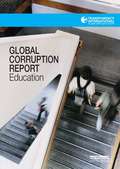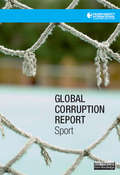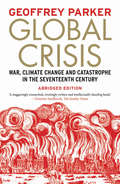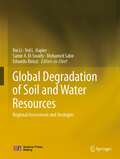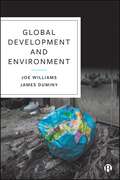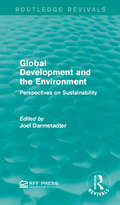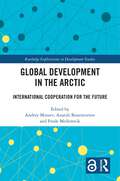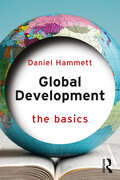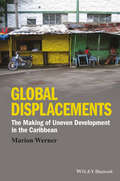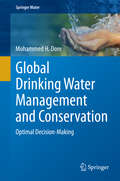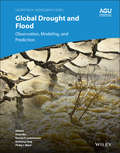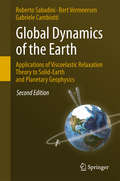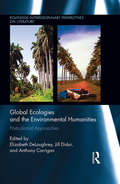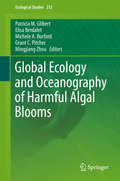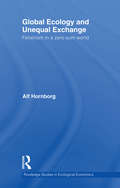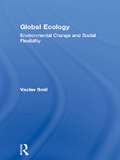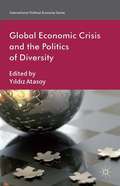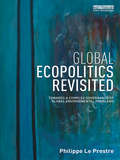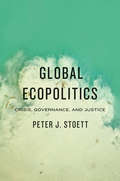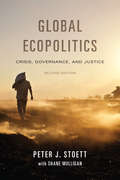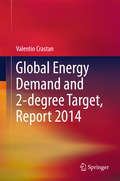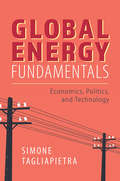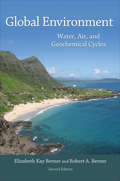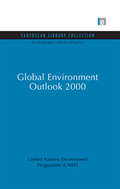- Table View
- List View
Global Corruption Report: Education
by Transparency InternationalCorruption and poor governance are acknowledged as major impediments to realizing the right to education and to reaching the Millennium Development Goal of universal primary education by 2015. Corruption not only distorts access to education, but affects the quality of education and the reliability of research findings. From corruption in the procurement of school resources and nepotism in the hiring of teachers, to the buying and selling of academic titles and the skewing of research results, major corruption risks can be identified at every level of the education and research systems. Conversely, education serves as a means to strengthen personal integrity and is a critical tool to address corruption effectively. The Global Corruption Report (GCR) is Transparency International’s flagship publication, bringing the expertise of the anti-corruption movement to bear on a specific corruption issue or sector. The Global Corruption Report on education consists of more than 70 articles commissioned from experts in the fields of corruption and education, from universities, think-tanks, business, civil society and international organisations. The Global Corruption Report on education and academic research will provide essential analysis for understanding the corruption risks in the sector and highlight the significant work that has already been done in the field to improve governance and educational outcomes. This will be an opportunity to pull together cutting edge knowledge on lessons learnt, innovative tools and solutions that exist in order to fight corruption in the education sector.
Global Corruption Report: Sport
by Transparency InternationalSport is a global phenomenon engaging billions of people and generating annual revenues of more than US$ 145 billion. Problems in the governance of sports organisations, fixing of matches and staging of major sporting events have spurred action on many fronts. Yet attempts to stop corruption in sport are still at an early stage. The Global Corruption Report (GCR) on sport is the most comprehensive analysis of sports corruption to date. It consists of more than 60 contributions from leading experts in the fields of corruption and sport, from sports organisations, governments, multilateral institutions, sponsors, athletes, supporters, academia and the wider anti-corruption movement. This GCR provides essential analysis for understanding the corruption risks in sport, focusing on sports governance, the business of sport, planning of major events, and match-fixing. It highlights the significant work that has already been done and presents new approaches to strengthening integrity in sport. In addition to measuring transparency and accountability, the GCR gives priority to participation, from sponsors to athletes to supporters an essential to restoring trust in sport.
Global Crisis: War, Climate Change and Catastrophe in the Seventeenth Century - Abridged Ed.
by Geoffrey ParkerAn accessible synthesis of the prescient best seller exploring seventeenth-century catastrophe and the impact of climate change First published in 2013, Geoffrey Parker’s prize-winning best seller Global Crisis analyzes the unprecedented calamities—revolutions, droughts, famines, invasions, wars, and regicides—that befell the mid-seventeenth-century world and wiped out as much as one-third of the global population, and reveals climate change to be the root cause. Examining firsthand accounts of the crises and scrutinizing the prevailing weather patterns during the 1640s and 1650s—longer and harsher winters, and cooler and wetter summers—Parker reveals evidence of disrupted growing seasons causing malnutrition, disease, a higher death toll, and fewer births. This new abridged edition distills the original book’s prodigious research for a broader audience while retaining and indeed emphasizing Parker’s extraordinary historical achievement: his dazzling demonstration of the link between climate change and worldwide catastrophe 350 years ago. Yet, the contemporary implications of his study are equally important: are we prepared today for the catastrophes that climate change could bring tomorrow? At half the original length, this user-friendly abridgment is ideal for students and general readers seeking a rapid handle on the key issues.
Global Degradation of Soil and Water Resources: Regional Assessment and Strategies
by Rui Li Ted L. Napier Samir A. El-Swaify Mohamed Sabir Eduardo RienziThis book focuses on soil and water conservation at global scale. It is a serious environmental problem that will threaten the socio-economic well-being of the majority of global population in future. The book examines the current situation of land degradation in multiple regions of the world and offers alternative approaches to solve the problems through sharing advanced technologies and lessons learned. It provides comprehensive assessment on characteristics, level and effect of degradation in different regions. It’s a highly informative reference both for researchers and graduate students.
Global Development and Environment
by Joe Williams James DuminyAvailable open access digitally under CC-BY licence. Development and environmental challenges are often framed at the global or planetary scale, but in a vague or apolitical manner. This book develops a theoretically rigorous and politicized concept of the planetary to intervene in contemporary debates on global development and to enhance our critical understanding of development as we approach the second quarter of the twenty-first century. Chapters explore key themes and processes including urbanization, demographic change, health, financialization, and infrastructure development. Referencing diverse cases and examples drawn from across the world, the book argues that the futures of global development are inseparable from environmental challenges and transformations.
Global Development and the Environment: Perspectives on Sustainability (Routledge Revivals)
by Joel DarmstadterIn preparation for the United Nation’s Conference on Environment and Development in Rio de Janeiro in June 1992, this study aimed to detail enduring environmental issues that might or might not have been considered at the conference. Originally published earlier that year, Global Development and the Environment questions the compatibility of goals for environmental protection, natural resource consequences and economic growth in relation to sustainability with essays on important topics such as biodiversity, agriculture and population issues. This title will be of interest to students of Environmental Studies and Economics.
Global Development in the Arctic: International Cooperation for the Future (Routledge Explorations in Development Studies)
by Anatoli Bourmistrov Frode Mellemvik Andrey MineevViewing the Arctic as a key region for global development in the 21st century, this book offers a cross-disciplinary conceptual framework for understanding what international cooperation is, why it is difficult and what kind of alternative views can apply in the Arctic. Written by Arctic experts, the book presents major trends and scenarios for international cooperation in the Arctic up to 2035 and future prospects for international cooperation in the Arctic in various sectors: energy, business and economy, transportation and logistics, climate change, diplomacy and security, culture, innovations, higher education and research. Implications of the scenarios for global development are discussed in the light of the United Nations Agenda for Global Development and Sustainable Development Goals (SDGs). The book offers a cross-disciplinary conceptual framework of international cooperation in the Arctic and discusses implications of this framework for global development. Filling the gap in analytical understanding of international cooperation, this book will be of interest to academics, students and professionals concerned with global development and the Arctic region.
Global Development: The Basics (The Basics)
by Daniel HammettHow do we try to make the world a better place, when the challenges of poverty, disease, war, conflict, and climate change continue to impact millions of lives? Global Development: The Basics is a lively and engaging introduction to the shifting landscape of global development, right from its origins, to present-day problems, and on to what the future for global development might look like. Recognising global development as an economic, political, and social project, this book tackles a series of critical questions: asking ‘what’ development is and how it is measured, where and to whom it is assumed to happen, how its approaches are developed, and whose benefit do they serve? The book invites readers to consider the complexities and challenges of the concept of development, including its historical roots in colonialism, and the geopolitical power relations which continue to set much of the agenda. It investigates whose voices are included or silenced in dominant approaches to development, and the growing importance of ‘non-traditional’ development funding and approaches. Covering key topics in the field, from economics and politics, through to gender and climate change, Global Development: The Basics is perfect for readers starting out in their understanding of global development.
Global Displacements
by Marion WernerChallenging the main ways we debate globalization, Global Displacements reveals how uneven geographies of capitalist development shape--and are shaped by--the aspirations and everyday struggles of people in the global South. Makes an original contribution to the study of globalization by bringing together critical development and feminist theoretical approaches Opens up new avenues for the analysis of global production as a long-term development strategy Contributes novel theoretical insights drawn from the everyday experiences of disinvestment and precarious work on people's lives and their communities Represents the first analysis of increasing uneven development among countries in the Caribbean Calls for more rigorous studies of long accepted notions of the geographies of inequality and poverty in the global South
Global Drinking Water Management and Conservation
by Mohammed H. DoreThis book discusses different drinking water treatment technologies and what contaminants each treatment method can remove, and at what costs. The production of drinking water requires adequate management. This book attempts to fill the existing knowlegde gap about (a) water treatment technologies and their costs, (b) risk assessment methods, (c) adverse health effects of chemical contaminants, (d) management protocols, and varying regulatory practices in different jurisdictions, and what successes are possible even with small financial outlays. Addressing water consulting engineers, politicians, water managers, ecosystem and environmental activists, and water policy researchers, and being clearly structured through a division in four parts, this book considers theoretical aspects, technologies, chemical contaminants and their possible elimination, and illustrates all aspects in selected international case studies. Source-water protection, water treatment technology, and the water distribution network are critically reviewed and discussed. The book suggests improvements for the management of risks and financial viability of the treatment infrastructure, as well as ways toward an optimal management of the distribution network through the risk-based management of all infrastructure assets.
Global Drought and Flood: Observation, Modeling, and Prediction (Geophysical Monograph Series)
by Qiuhong Tang Huan Wu Dennis P. Lettenmaier Philip J. WardRecent advances in the modeling and remote sensing of droughts and floods Droughts and floods are causing increasing damage worldwide, often with devastating short- and long-term impacts on human society. Forecasting when they will occur, monitoring them as they develop, and learning from the past to improve disaster management is vital. Global Drought and Flood: Observation, Modeling, and Prediction presents recent advances in the modeling and remote sensing of droughts and floods. It also describes the techniques and products currently available and how they are being used in practice. Volume highlights include: Remote sensing approaches for mapping droughts and floods Physical and statistical models for monitoring and forecasting hydrologic hazards Features of various drought and flood systems and products Use by governments, humanitarian, and development stakeholders in recent disaster cases Improving the collaboration between hazard information provision and end users The American Geophysical Union promotes discovery in Earth and space science for the benefit of humanity. Its publications disseminate scientific knowledge and provide resources for researchers, students, and professionals.
Global Dynamics of the Earth: Applications of Viscoelastic Relaxation Theory to Solid-Earth and Planetary Geophysics
by Roberto Sabadini Bert Vermeersen Gabriele CambiottiThis volume opens up new perspectives on the physics of the Earth's interior and planetary bodies for graduate students and researchers working in the fields of geophysics, planetary sciences and geodesy. It looks at our planet in an integrated fashion, linking the physics of its interior to geophysical and geodetic techniques that record, over a broad spectrum of spatial wavelengths and time scales, the ongoing modifications in the shape and gravity field of the planet. Basic issues related to the rheological properties of the Earth and to its slow deformation are considered, in both mathematical and physical terms, within the framework of an analytical relaxation theory. Fundamentals of this theory are developed in the first two Chapters. Chapters 3-9 deal with a wide range of applications, ranging from changes in the Earth's rotation to post-seismic deformation and from sea-level variations induced by post-glacial rebound to tidal deformation of icy moons of the Solar System. This Second Edition improves substantially our formalism implementing compressibility in viscoelastic relaxation. Chapter 5 now contains new developments in the physics of the gravitational effects of large earthquakes at subduction zones, made possible by new gravity data from space missions. The new Chapter 9 of this Second Edition on deformation and stresses of icy moons enlarges the applications of the book to Planetology, dealing with the additional complications in the theory of viscoelastic relaxation introduced by the shallow low-viscosity zones and inviscid water layers of the moons of Jupiter and Saturn.
Global Ecologies and the Environmental Humanities: Postcolonial Approaches (Routledge Interdisciplinary Perspectives on Literature)
by Edited by Elizabeth DeLoughrey, Jill Didur, and Anthony CarriganThis book examines current trends in scholarly thinking about the new field of the Environmental Humanities, focusing in particular on how the history of globalization and imperialism represents a special challenge to the representation of environmental issues. Essays in this path-breaking collection examine the role that narrative, visual, and aesthetic forms can play in drawing attention to and shaping our ideas about long-term and catastrophic environmental challenges such as climate change, militarism, deforestation, the pollution and management of the global commons, petrocapitalism, and the commodification of nature. The volume presents a postcolonial approach to the environmental humanities, especially in conjunction with current thinking in areas such as political ecology and environmental justice. Spanning regions such as Africa, Asia, Eastern Europe, Latin America and the Caribbean, Australasia and the Pacific, as well as North America, the volume includes essays by founding figures in the field as well as new scholars, providing vital new interdisciplinary perspectives on: the politics of the earth; disaster, vulnerability, and resilience; political ecologies and environmental justice; world ecologies; and the Anthropocene. In engaging critical ecologies, the volume poses a postcolonial environmental humanities for the twenty-first century. At the heart of this is a conviction that a thoroughly global, postcolonial, and comparative approach is essential to defining the emergent field of the environmental humanities, and that this field has much to offer in understanding critical issues surrounding the creation of alternative ecological futures.
Global Ecology and Oceanography of Harmful Algal Blooms (Ecological Studies #232)
by Patricia M. Glibert Elisa Berdalet Michele A. Burford Grant C. Pitcher Mingjiang ZhouHarmful algal blooms (HABs) - blooms that cause fish kills, contaminate seafood with toxins, or cause human or ecological health impacts and harm to local economies - are occurring more often, in more places and lasting longer than in past decades. This expansion is primarily the result of human activities, through increased nutrient inputs and various aspects of climate change.The Global Ecology and Oceanography of Harmful Algal Blooms (GEOHAB) programme promoted international collaboration to understand HAB population dynamics in various oceanographic regimes and to improve the prediction of HABs.This volume introduces readers to the overarching framework of the GEOHAB programme, factors contributing to the global expansion of harmful algal blooms, the complexities of HABs in different habitats, and the forward-looking issues to be tackled by the next generation of GEOHAB, GlobalHAB. The programme brought together an international team of contributing scientists and ecosystem managers, and its outcomes will greatly benefit the international research community.
Global Ecology and Unequal Exchange: Fetishism in a Zero-Sum World (Routledge Studies In Ecological Economics Ser. #14)
by Alf HornborgIn modern society, we tend to have faith in technology. But is our concept of ‘technology’ itself a cultural illusion? This book challenges the idea that humanity as a whole is united in a common development toward increasingly efficient technologies. Instead it argues that modern technology implies a kind of global ‘zero-sum game’ involving uneven resource flows, which make it possible for wealthier parts of global society to save time and space at the expense of humans and environments in the poorer parts. We tend to think of the functioning of machines as if it was detached from the social relations of exchange which make machines economically and physically possible (in some areas). But even the steam engine that was the core of the Industrial Revolution in England was indissolubly linked to slave labour and soil erosion in distant cotton plantations. And even as seemingly benign a technology as railways have historically saved time (and accessed space) primarily for those who can afford them, but at the expense of labour time and natural space lost for other social groups with less purchasing power. The existence of technology, in other words, is not a cornucopia signifying general human progress, but the unevenly distributed result of unequal resource transfers that the science of economics is not equipped to perceive. Technology is not simply a relation between humans and their natural environment, but more fundamentally a way of organizing global human society. From the very start it has been a global phenomenon, which has intertwined political, economic and environmental histories in complex and inequitable ways. This book unravels these complex connections and rejects the widespread notion that technology will make the world sustainable. Instead it suggests a radical reform of money, which would be as useful for achieving sustainability as for avoiding financial breakdown. It brings together various perspectives from environmental and economic anthropology, ecological economics, political ecology, world-system analysis, fetishism theory, semiotics, environmental and economic history, and development theory. Its main contribution is a new understanding of technological development and concerns about global sustainability as questions of power and uneven distribution, ultimately deriving from the inherent logic of general-purpose money. It should be of interest to students and professionals with a background or current engagement in anthropology, sustainability studies, environmental history, economic history, or development studies.
Global Ecology: Environmental Change and Social Flexibility
by Vaclav SmilThe magnitude and rapidity of global environmental change threatens the perpetuation of life on Earth. Many aspects of this crisis are familiar to us - the destruction of tropical rainforests, the hole in the Antarctic ozone, desertification, soil erosion - yet we avoid the underlying challenge of a rapidly deteriorating ecological system and the breadth and complexity of responses demanded. Integrating an analysis of both social and environmental needs, the book explores the premises and problems of different paths towards global management. With its emphasis on flexible response, Global Ecology furthers our understanding of biospheric change and of our abilities and weaknesses in managing the transition to a sustainable society.
Global Economic Crisis and the Politics of Diversity
by Yildiz AtasoyAn interdisciplinary group of scholars from the global North and South critically explore the global deepening of market economy models. In case studies including Asia, the Middle East and Latin America, they examine the associated tensions of livelihood and ecology in the current context of global economic crisis, considering issues of natural ecology, water use, health, childcare, technology and work, migration, and economic growth. The analysis of the complex connections between domestic and global dynamics across diverse cases and issues helps reveal that state-centric approaches are still hovering over the politics of restructuring through which conformity to economic growth is addressed.
Global Ecopolitics Revisited: Towards a complex governance of global environmental problems
by Philippe Le PrestreFaced with worsening environmental indicators, cooperation hurdles, and the limited effectiveness of current institutions, reforming international environmental governance has proven elusive, despite various diplomatic initiatives at the United Nations level over the last two decades. Overcoming the current dead end, however, may rest less in devising new arrangements than in challenging how the problem has been approached. Presenting a multifaceted exploration of some of the key issues and questions in global ecopolitics, this book brings together recent advances in research on global environmental governance in order to identify new avenues of inquiry and action. Each chapter questions elements of the current wisdom and covers a topic that lies at the heart of global environmental governance, including the reasons for engagement, the evolving relationship between science and policy, the potential and limits of the European Union as a key actor, the role of developing and emergent countries, and the contours of a complex governance of international environmental issues. Laying the foundation for rethinking at a time of great transformation in global ecopolitics, this book will be important reading for students of environmental politics and governance. It will also be of relevance to policy makers with an interest in going beyond the prevailing discourse on this crucial topic.
Global Ecopolitics: Crisis, Governance, And Justice
by Peter StoettDespite sporadic news coverage of extreme weather, international conventions on climate change, or special UN days, rarely do we participate in a sustained analysis of environmental policy making. To remedy this shortcoming and to propel the discussion forward, Peter J. Stoett provides a concise introduction to environmental governance. Through seven case studies, Stoett analyzes the ability of international policy to provide environmental protection and discusses the ever-present factors of equality, sovereignty, and human rights integral to these issues. While providing a panoramic view of the actors and structures producing these policies, Stoett reminds readers that the topic is personal, that responsible governance is not solely the charge of governments but of individuals and communities as well.
Global Ecopolitics: Crisis, Governance, and Justice, Second Edition
by Peter StoettDespite sporadic news coverage of extreme weather events, high-level climate change diplomacy, special UN days of celebration, and popular media references to impending ecological collapse, most students are not exposed to the detailed presentation and analysis of the international relations and diplomacy of environmental policy-making. Comprehensive and accessibly written for first-year or second-year undergraduates, the second edition of Global Ecopolitics provides students with a panoramic view of the policymakers and the structuring bodies involved in the creation of environmental policies. Detailing a considerable amount of environmental activity since its initial 2012 publication, this up-to-date second edition uses an applicable framework of systemic analysis and important case studies that push students to form their own conclusions about past efforts, present needs, and future directions.
Global Energetics of the Atmosphere: Earth–Atmosphere Equilibrium, Greenhouse Effect, and Climate Change (Springer Atmospheric Sciences)
by Boris M. SmirnovThis book looks at global atmospheric processes from a physical standpoint using available current and past observational data taken from measurements of relevant atmospheric parameters. It describes various aspects of the current atmospheric state and its future evolution, focusing primarily on the energetic balance of the Earth and atmosphere, and taking into consideration the multi-faceted global equilibrium between these two systems, carbon, and water. The analysis presented in this book restricts itself to those objects and processes that allow us to obtain reliable conclusions and numerical estimations, in contrast to current climate models with much larger numbers of parameters for describing the same problems. As a result, in spite of the roughness of numerical parameters, the book unveils a reliable and transparent physical picture of energetic phenomena in the global atmosphere. In particular, it shows that approximately only one-fourth of atmospheric water returns from the atmosphere to the Earth in the form of free molecules. It was shown that the contemporary warming of our planet has an anthropogenic character, and that the average global temperature increases due to an increase of the concentration of atmospheric CO2 molecules, via an increase in atmospheric moisture, as well as an increase in the amount of aerosols in the atmosphere. Accumulation of atmospheric carbon dioxide plays a subsidiary role in this process and gives approximately one-third in a change of the global temperature, while an increase in the amount of atmospheric water by as little as only 0.3% per year explains the observed warming of the Earth. The book shows how the greenhouse instability of the atmosphere evidently has its origins in the Eocene epoch, presenting an analysis of the influence of various types of global energetic processes on the climate that differs from the official stance on these problems.
Global Energy Demand and 2-degree Target, Report 2014
by Valentin CrastanThis report takes a neutral and independent point of view in attempting to show concrete ways to achieve the goal of reducing CO2 emissions and limiting global warming to the 2-degree target. It presents an overall picture spanning all key countries. In the report, the temporal evolution of the main parameters is given from 1970 to 2011 for all regions of the world and all G-20 countries, starting from the basic data, gross domestic consumption. The parameters are then extrapolated to 2030, taking into account current trends, local factors and the requirements of the 2-degree climate target. An important basis is the structure of the current energy consumption and energy flows of all regions of the world and all G-20 countries, which is analyzed in the appendix in detail and reproduced as clearly as possible. The reports from climate science make it clear that with a greater level of warming, adaptation is the more expensive option. Compliance with the 2-degree climate target is a challenge, but not impossible. The book is intended not only for the scientific community but also for decision makers in government and industry.
Global Energy Fundamentals: Economics, Politics, and Technology
by Simone TagliapietraThis book provides a rigorous, concise guide to the current status and future prospects of the global energy system. As we move away from fossil fuels and toward clean energy solutions, the complexity of the global energy system has increased. Tagliapietra cuts through this complexity with a multidisciplinary perspective of the system, which encompasses economics, geopolitics, and basic technology. He goes on to explore the main components of the global energy system - oil, natural gas, coal, nuclear energy, bioenergy, hydropower, geothermal energy, wind energy, solar energy, marine energy - as well as energy consumption and energy efficiency. It then provides an in-depth analysis of the pivotal issues of climate change and of energy access in Africa.
Global Environment
by Elizabeth Kay Berner Robert A. BernerThis newly revised edition of Global Environment discusses the major elements of the geochemical cycles and global fluxes found in the atmosphere, land, lakes, rivers, biota, and oceans, as well as the human effects on these fluxes. Retaining the strengths of the original edition while incorporating the latest discoveries, this textbook takes an integrated, multidisciplinary, and global approach to geochemistry and environmental problems and introduces fundamental concepts of meteorology, surficial geology (weathering, erosion, and sedimentation), biogeochemistry, limnology, and oceanography. New concepts and information in this updated edition include changes of atmospheric carbon dioxide over geologic time, major advances in the study of chemical weathering of rocks, ocean acidification, and important environmental problems, such as the amelioration of the acid rain problem due to reduction in sulfur deposition, problems with nitrification of soils and lakes, and eutrophication of rivers and estuaries. An expanded chapter explores atmospheric chemistry and changing climate, with the most up-to-date statistics on CO2, the carbon cycle, other greenhouse gases, and the ozone hole. Only requiring a fundamental understanding in elementary chemistry, yet taking into account extensive and current data, this text is ideal for students in environmental geochemistry, environmental geology, global change, biogeochemistry, water pollution, geochemical cycles, chemical oceanography, and geohydrology, and serves as a valuable reference for researchers working on global geochemical and environmental issues.Revised edition takes a close look at global fluxes involving the atmosphere, land, lakes, rivers, biota, and oceans, and the human effects on these fluxes Detailed discussion of basic concepts including meteorology, surficial geology (weathering, erosion, and sedimentation), biogeochemistry, limnology, and oceanography An expanded up-to-date chapter on atmospheric chemistry and changing climate, including CO2, other greenhouse gases, and ozone Presentation of major advances in the study of chemical weathering Discussion of current environmental topics Global coverage of environmental problems involving water
Global Environment Outlook 2000 (Sustainable Development Set)
by United Nations (Unep)'The continued poverty of the majority of the planet's inhabitants and excessive consumption by the minority are the two major causes of environmental degradation The present course is unsustainable and postponing action is no longer an option. Inspired political leadership and intense cooperation across all regions and sectors will be needed to put both existing and new policy instruments to work. ' From the Synthesis Global Environment Outlook 2000 (GEO-2000) is a comprehensive and authoritative review and analysis of environmental conditions around the world. It is the flagship publication of the world's leading environmental organization, the United Nations Environment Programme (UNEP), and is based on information provided by more than 30 regional and international collaborating centres. The book presents a region-by-region analysis of the state of the world's environment, highlighting key global concerns and making recommendations for policy action. The regions covered include Africa, Asia and the Pacific, Europe and Central Asia, Latin America and the Caribbean, North America, West Asia and the Polar Areas. Chapter 1: Global Perspectives describes the main drivers of environmental change, such as the economy, population growth, political organization and regionalization, as well as potential impacts of recent global developments including the growth of the consumer culture, trade and international debt. Chapter 2: The State of the Environment provides a global and region-by-region overview of the environment at the end of the second millennium. The chapter covers global issues such as ozone, climate change, El Nifio and nitrogen loading, and universal issues of land and food, forests, biodiversity, freshwater, marine and coastal areas, atmosphere and urban areas. Chapter 3: Policy Responses reviews the broad range of policy instruments and responses being used to address environmental issues, including multilateral environmental agreements, and analyses the difficulties of compliance, implementation and assessment. Chapter 4: Future Perspectives looks at environmental issues that will require priority attention in the 21st century and some alternative policy options that could be used in the regions. Chapter 5: Outlook and Recommendations makes recommendations for future action based on the environmental legacy left by past and present policy and management systems. GEO-2000 will be the benchmark reference and guide to the state of the global environment. Written in clear, non-technical language and supported throughout by informative graphics and tables, it is essential reading for all those involved in environmental policy making, implementation and assessment, and for researchers and students of regional and global environmental issues. Originally published in 1999
